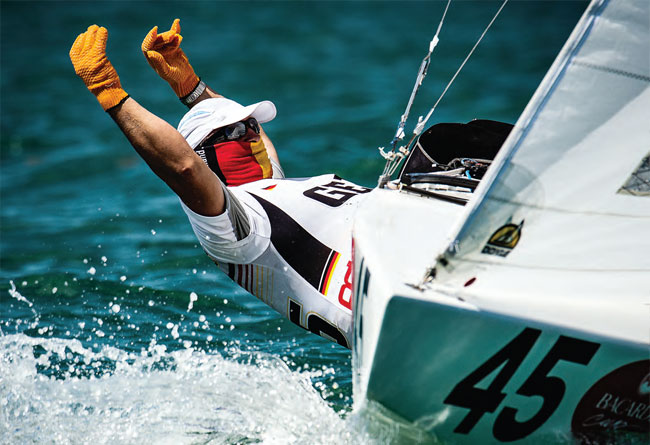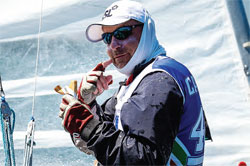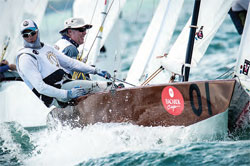

Seahorse readers will by now be familiar with the growing number of images we publish that include instances of some of the world’s best-known racing sailors competing while wrapped up like desert nomads. There is good reason for that of course; even so, the full extent of the active racer’s risk of sun-induced damage can still fairly be described as less than fully appreciated. Associate Professor of Dermatology at the Medical College of Wisconsin Edit Olasz Harken looks at both the risks to ourselves and at the steadily growing side-effects on the waters on which we compete
‘Sunscreen is the new margarine’, ‘Hawaii just banned your favourite sunscreen to protect its coral reefs’, ‘Is your sunscreen poisoning you?’ – these and similar headlines have been creating a lot of buzz in the news lately. Sunscreen is a hot topic and the closer one gets to it nowadays the hotter it becomes – you may even crash and burn like Icarus, who ignored his father’s advice and flew close to the sun on wings made of feathers and wax.
Luckily dermatologists (like myself), sunscreen manufacturers, marine biologists and scientists studying potential benefits and harms of sunscreens at least agree on one fact: applying a proven sunscreen will reduce your exposure to burning from the sun. They may even agree that proper use of sunscreen decreases the risk of skin cancer, although with a lot of ifs and buts.
The rest, frankly, is becoming a field of controversies where the battle of opposing and usually polarised opinions plays out gruesomely, creating the type of social media havoc that has unfortunately permeated our world lately.
So much is going on that the American Academy of Dermatology has recently decided to fund independent research to investigate the claims about the coralharming effects of certain chemical UV filters commonly present in sunscreens.

Furthermore, in February the US Food and Drug Administration published its own new proposed sunscreen regulatory guidelines: of 16 active ingredients currently used in popular sunscreens only zinc oxide and titanium dioxide are GRASE (generally recognised as safe and effective); the FDA requested more detail on another 12 ingredients; the final two ingredients are not GRASE because of safety issues.
Tropospheric ultraviolet radiation (TUV/UVR) that reaches the earth’s surface consists mainly of long wavelength ultraviolet A (UVA) (320-400nm) radiation and only a minority (estimated five per cent) of short wavelength ultraviolet B (UVB) (280-320nm). UVA rays travel deeper into the skin and cause indirect DNA damage by free radicals, destroy collagen and whip up elastin which result in premature ageing (A for ageing).
UVB rays stop short at the upper layer of the skin and cause direct DNA mutation, sunburn (B for burning) and are the main cause of skin cancer. UVB penetration is increased by thinning of the ozone layer and it has been estimated that a one per cent decrease in ozone layer increases melanoma mortality by around one to two per cent.
UVC (200-280nm) does not reach the surface of the earth as it is screened out by atmospheric oxygen as well as being absorbed by the ozone layer.
UVR is responsible for a wide variety of different acute and chronic effects on the skin. Acute responses of human skin to UVR include photodamage, erythema, mutation, immunosuppression, synthesis of Vitamin D and tanning. Chronic effects include photoageing and photocarcinogenesis, which is considered to be induced by mutation and immunosuppression.
The World Health Organisation (WHO) declared UV radiation carcinogenic in 2012 and a study in Australia showed that 65-90 per cent of melanomas and almost 100 per cent of keratinocyte cancers (basal cell carcinomas and squamous cell carcinomas) can be attributed to UV exposure. Accordingly, most keratinocyte cancers are found on sunexposed areas and cancers on the lips and ears are at highest risk for spreading.
Intermittent, high-intensity sun exposure resulting in sunburn especially at a younger age is thought to be associated with melanoma and a large study showed that more than five severe sunburns between the age of 15 and 20 increase the risk of melanoma by 80 per cent. Skin incurs cumulative mutational damage also through repeated lower-intensity sun exposure, and that kind of longterm daily suberythemal (just to make you a little pink) exposure is thought to cause precancers and the majority of keratinocyte cancers.
Sailors certainly are at high risk. The constant exposure of sun, wind and water, what I regard as the ‘triple threat’, wreaks havoc on the skin. Of course, these statistics fit mainly people with fair skin, those who always burn before they tan. In fact, people with fair skin are approximately 70 times more likely to develop skin cancer than those with black skin. Besides ‘being a sailor’, the inability to tan, or burning and freckling on sun exposure, having a lot of moles or atypical moles, extensive unprotected sun exposure or tanning bed use at early life and genetic predisposition can all increase skin cancer risk. Knowing your risk factors can be lifesaving.
Dermatologists consider sailors a highrisk population, so no wonder when I told my colleagues many years ago that I fell in love with a sailor called Peter Harken, the first question they asked was: ‘Does he have really bad skin?’ Peter credits his olive skin and quick tanning ability to his Dutch father and his distant ancestors who owned a shipping company. According to him, they must have ‘mingled with the Cubans’ en route to South America and succeeded in bringing genes for olive skin into his northern European family.
Melanin (pigment produced by melanocytes) in the skin acts like a natural umbrella that protects by scattering and absorbing UV rays. In addition, it has excellent antioxidant and free radical scavenging properties. The efficacy of melanin as a sunscreen is calculated to be about 1.5-2 SPF and can be as high as 4 SPF, implying that it absorbs 50-70 per cent of UV rays. An SPF 2 means the doubling of protection of skin against sunburn. Hence there are still 50-30 per cent UV rays that enter the tanned skin and cause photodamage. People with red hair have a different, less effective melanin called pheo - melanin that is associated with certain mutations and confers an increased risk of melanoma and keratinocyte cancers.
Sailors who have olive skin and tan well may prefer to have the sun-kissed bronze look while still enjoying reduced risk of skin cancer… but crow’s feet and etched-in forehead lines may come early too. Botox to smooth wrinkles is more expensive than using sunscreen to prevent them.
Sunscreens are proven to markedly reduce UVR-induced DNA damage and premature photoageing. Several interventional studies showed use of sunscreen can also reduce the incidence of skin cancer.
One of the most successful health campaigns in Australia, the famous Slip, Slop, Slap! Campaign, was launched in 1981 and has resulted in a significant decrease in melanoma cases (25 per 100,000 in 1996 down to 14 per 100,000 in 2010 among people aged 20-24). It’s no wonder that the skincare product that is most recommended by dermatologists is a sunscreen.
I’d like to emphasise that we consider that sun-protective gear, including UPF clothing, hats (best are wide brimmed and/or with neck protection) and polarised sunglasses, and shade seeking are the best method for prevention of sun-induced damage. Ambient and low-intensity sun exposure has a lot of beneficial effects including Vitamin D production, but that discussion would take up another page so I better leave it alone.
So what is the new buzz about sunscreens? Concerns and controversies mainly surround two common ingredients, oxybenzone and octinoxate, and focus on both human health and marine environmental impact. As a matter of fact, all sunscreens are not created equally.
Beside the packaging and formulation (from the sprays, which are disliked by dermatologist, to liquids, creams and sticks), sunscreens are categorised by their active ingredients which are the UV filters.
In the US the FDA regulates sunscreens as over-the-counter (OTC) drugs and requires that these ingredients be listed separately on the label under ‘active ingredients’. Some other countries, including countries in the European Union, however, do not have this requirement, so it is more difficult to find them among all the other ingredients.
In addition, a lot of the chemical filters can carry several different names and are listed as such according to each country’s rules. The two main categories are insoluble, aka physical, mineral or inorganic filters, and the soluble, aka chemical or organic filters. Physical vs chemical, although the most frequently used terms, can be misleading as both zinc oxide and titanium dioxide are actually chemicals.
Zinc oxide and to a lesser extent titanium dioxide reflect a broad spectrum of UV wavelengths (both UVB and UVA) and are the only two filters that have been deemed GRASE in the recent FDA proposal. They are very stable, and as long as they sit on the skin surface they do the job.
Chemical UV filters are a variety of soluble organic compounds that absorb a range of UV wavelengths and convert it to heat. Most only filter a limited spectrum, therefore many different filters need to be mixed (or put together as a puzzle) into sunscreen to give a broad (UVB and UVA) coverage. Some chemical filters can be degraded by heat and have to be stabilised.
The number of chemical filters is limited in the US with only a few providing protection against UVA, including oxybenzone, meradimate and avobenzone. In its recent regulatory proposal the FDA is planning to ask for additional safety data for all of the US chemical filters. Although permissible in the European Union, Australia and New Zealand, very broad-spectrum chemical filters (Tinosorb M and Mexoryl XL) are prohibited by the FDA due in part to the lack of studies pertaining to absorption.
Sunscreen manufacturers so far have not conducted the FDA-required studies for the very broad-spectrum filters, but in my opinion the new environmental concerns regarding the existing US chemical filters may well prompt them to do so.
In general, due to their insoluble and light-reflecting characteristics, sunscreens with mineral filters are more difficult to formulate and are less cosmetically elegant. Micronising or nanosising the minerals improves the ‘white cast’ but may also decrease the efficiency. Chemical filters are transparent and therefore more cosmetically acceptable.
Sun protection factor (SPF) only measures how well the sunscreen protects from UVB rays, but as a general rule the higher the SPF the broader the coverage becomes.

Above: as a Star sailor of 40 years’ standing (and former world champion) Paul Cayard is also keeping at the front in the natty headgear stakes… Five-time Olympic medallist Torben Grael is another high-profile convert in the Stars, showing that coming from the hot Brazilian climate gives you no special privileges. Two good examples of top sailors making the unusual quite normal while encouraging others (below) to follow their example

UVA filtering capacity of sunscreens is determined, regulated and measured differently in different countries. Unfortunately, although the SPF number may be pretty high on some sunscreens, it does not always guarantee good protection in the UVA range that is most damaging.
One area of ongoing concern is the possibility that certain chemical sunscreen ingredients, such as oxybenzone, may have estrogenic and anti-androgenic impacts on mammals, with special concern for children and pregnant women.
Oxybenzone is a very small molecule that rapidly gets absorbed into the circulation. It is secreted into the urine and can be detected in breast milk. In addition, it is bioaccumulated and biomagnified which leads to increasing amounts appearing throughout the marine food chain.
According to the US Center of Disease Control, approximately 97 per cent of Americans are exposed to oxybenzone. About 80 per cent of US sunscreens contain oxybenzone and there are plentiful cosmetic products that use it.
Many animal studies have shown harmful hormonal effects of oxybenzone; however, it has been calculated that nearly 300 years of daily sunscreen application would be necessary to reach similar exposure levels to oxybenzone that caused endocrine abnormalities in animal studies.
Importantly, oxybenzone has not been demonstrated to accumulate in the blood. What about the coral reefs? In May 2018 Hawaii passed state legislation that sparked much debate and controversy. The legislation restricts the use of personal care products including sunscreens that contain oxybenzone and octinoxate, effective from 1 January 2021.
The Republic of Palau in the western Pacific followed suit shortly afterward and the city of Key West just banned the use of the same two filters in February 2019, effective from 2021. The mayor of Key West adds simply: ‘There are thousands of sunscreens out there, and we have one reef.’
These laws were prompted by several studies showing increased amounts of active chemical sunscreen ingredients in coastal waters, with supportive evidence pointing to harmful effects of oxybenzone and octinoxate on coral reefs, a crucial component of aquatic ecosystems.
Coral reefs occupy less than 0.1 per cent of the earth’s ocean surface, yet they provide habitat for at least 25 per cent of all marine species. It is estimated that 25 per cent of sunscreen applied to the skin is washed off within 20 minutes of immersion, releasing approximately 14,000 tons of sunscreen into the waters surrounding coral reefs every year.
Large tourist populations who frequent Hawaii probably contribute to excess oxybenzone and octinoxate found along the surrounding ocean shores. In addition, water-waste treatment facilities do not have effective means of filtering out these organic compounds, leading to additional contamination of coastal waters via sewage drop-off.
It has further been shown that four out of five sampled sites of ocean around the Hawaiian islands displayed detectable oxybenzone levels of 100 parts per trillion. The fifth site demonstrated oxybenzone levels of 19.2 parts per billion. Opposing scientists point out that these were only a few random samples in very concentrated areas and cannot be interpolated to other reefs throughout the world. In addition, some scientists – and manufacturers of sunscreens – point out that the major cause of coral bleaching is rising ocean temperature due to climate change and other environmental pollution.

When coral is exposed to oxybenzone and octinoxate it undergoes a bleaching phenomenon due to loss of membrane integrity and loss of photosynthetic pigments in zooxanthellae, a species of algae released from coral. Coral and zooxanthellae have a delicate symbiotic relationship wherein coral provides the zooxanthellae with a protective refuge and resources needed for algae photosynthesis. The algae are later consumed by the coral, providing nourishment needed for coral growth and expansion. When coral reefs are exposed to stress, such as chemical bleaching, algae dissociate from the coral, thereby disrupting this relationship leading to decreased coral viability. Oxybenzone and octinoxate were also named in other mechanisms that directly damage coral larvae DNA.
Some sunscreen manufacturers responded to the new legislation by pointing out that such a measure could compromise the health of both tourists and native Hawaiians, as it prohibits a large portion of available sunscreen products. Lots of dermatologists are also worried that banning the most frequently used sunscreen ingredients allied with fake news such as ‘sunscreen is the new margarine’ will decrease the use of sunscreens and hence increase the risk of skin cancer in large populations.
I am a dermatologist, a scientist, a sailor (don’t be fooled, I didn’t write an article in Seahorse due to my sailing merits), coral reef enthusiast and care deeply about our seas. In my personal opinion, we have a choice to use proven safe sunscreen ingredients.
No doubt more research is needed for certain filters and I dare to trust the industry that they will perform the required testing that will prove or disprove current concerns and provide us with better choices. I support the American Academy of Dermatology decision to fund independent research about coral safety. I sincerely hope that ultimately we will find those sunscreens that are best for us and our environment so we can keep doing what we love: sailing.>
[Disclosure: Edit Harken MD, PhD is also co-founder of Harken Derm which offers a sunscreen with only mineral filters]
Click here for more information on Harken Derm »
We invite you to read on and find out for yourself why Seahorse is the most highly-rated source in the world for anyone who is serious about their racing.
To read on simply SIGN up NOW
Take advantage of our very best subscription offer or order a single copy of this issue of Seahorse.
Online at:
www.seahorse.co.uk/shop and use the code TECH20
Or for iPad simply download the Seahorse App at the iTunes store


